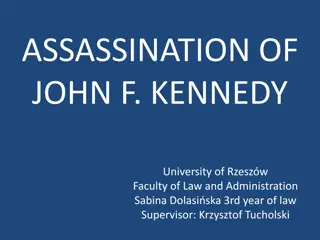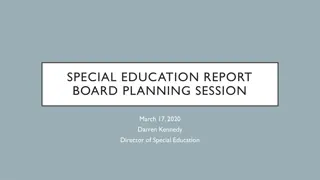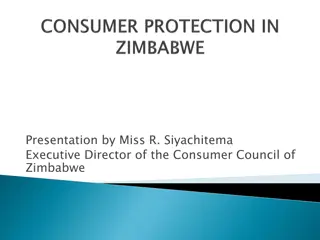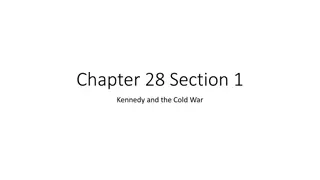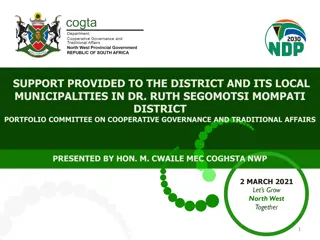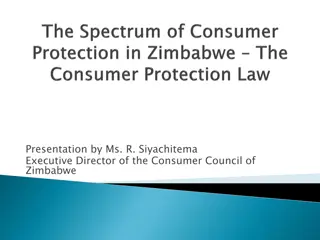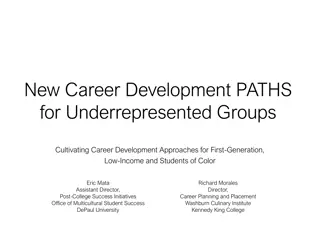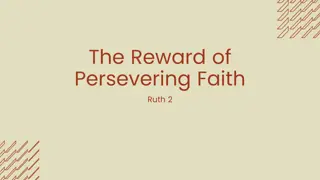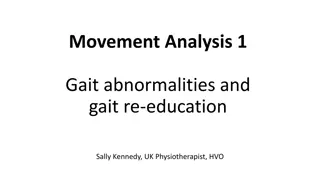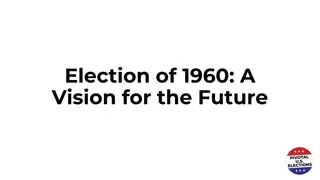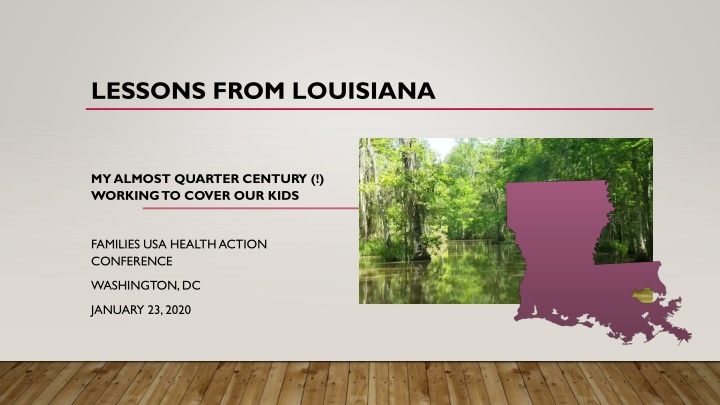
Lessons from Louisiana: Improving Children's Health Coverage Over Two Decades
"Discover the transformation in children's health coverage in Louisiana from 1997 to 2020, reflecting on significant policy changes, budget challenges, and the impact of eligibility maintenance efforts. Learn how streamlining and simplifying eligibility processes have enhanced coverage for children. Explore the key factors influencing public health coverage policies in Louisiana and the role of Medicaid/CHIP participation rates in improving access to healthcare for children."
Download Presentation

Please find below an Image/Link to download the presentation.
The content on the website is provided AS IS for your information and personal use only. It may not be sold, licensed, or shared on other websites without obtaining consent from the author. If you encounter any issues during the download, it is possible that the publisher has removed the file from their server.
You are allowed to download the files provided on this website for personal or commercial use, subject to the condition that they are used lawfully. All files are the property of their respective owners.
The content on the website is provided AS IS for your information and personal use only. It may not be sold, licensed, or shared on other websites without obtaining consent from the author.
E N D
Presentation Transcript
LESSONS FROM LOUISIANA MY ALMOST QUARTER CENTURY (!) WORKING TO COVER OUR KIDS FAMILIES USA HEALTH ACTION CONFERENCE WASHINGTON, DC JANUARY 23, 2020
THEN AND NOW: CHILDRENS PUBLIC HEALTH COVERAGE IN LOUISIANA 1997 2020 Fewer than1in 20 children and youth are uninsured percentage well below national average. Almost 1 in 3 children and youth were uninsured 3rdhighest percentage in country. Clearly struggling with unintended effects of Welfare Reform. Nation s 5th best Medicaid/CHIP participation rate (96.5%). Medicaid Expansion backlash survivor.
Provisions in statute: 12- months continuous eligibility, Express Lane Eligibility. Largely apolitical great gains made under both Republican and Democratic governors. FACTORS THAT HAVE INFLUENCED CHILDREN S HEALTH COVERAGE POLICY IN LOUISIANA Provisions not in statute: ex parte renewals; eligibility culture change. Budget $hortfalls!!!!!!!!
Streamlining and simplifying eligibility works! Children are relatively cheap to cover but still require major state $$. Fewer than half the states had adopted 12 months continuous eligibility for children in their Medicaid programs before ACA. Even fewer states have adopted automated enrollment options using other data, Express Lane Eligibility (ELE). SNAP-assisted enrollment (persons who get SNAP + certainto be eligible for Medicaid). Automatically accepts determinations from federal Marketplace. BUDGET REALITIES OF COVERING CHILDREN IN LA (AND ELSEWHERE)
BE (VERY) THANKFUL FOR THE ELIGIBILITY MAINTENANCE OF EFFORT IN MEDICAID & CHIP States cannot adopt more restrictive eligibility for kids with family income 300% FPL than those in place March 23, 2010, between now and October 1, 2027. Not only Standards but Methodologies and Procedures. MOE held (and holds) back a tsunami of changes adverse to children s coverage. More frequent renewals. More documentation. Face-to-face application and renewal interviews. This Photo by Unknown Author is licensed under CC BY-SA
Stating the obvious: children cant apply and renew health coverage for themselves! Dependent on actions of another. CONTINUATION OF MAINTENANCE OF EFFORT IN 2018 WAS A HUGE WIN FOR CHILDREN S COVERAGE More stringent eligibility methodologies and procedures = substantially fewer eligible children with public coverage. Last 20+ years proved covering kids is not A Field of Dreams ; if we build it, they may come. No guarantees.
Decisions to apply and stay enrolled in public health coverage programs are driven by behavioral economic rather than classical economic principles. BEHAVIORAL ECONOMICS AND CHILDREN S HEALTH COVERAGE
CLASSICAL ECONOMIC THEORY ASSUMES INDIVIDUALS HAVE UNBOUNDED: Rationality Unlimited capacity to acquire and process info and never make mistakes calculating cost vs benefits. Willpower Can always carry through any decision they calculate as optimal. Self-Interest Always act in their own best interest.
BOUNDED RATIONALITY IMPLICATIONS FOR MEDICAID AND CHIP ENROLLMENT People make errors in interpreting information. I ll need to be drug tested to enroll or keep my child enrolled I ll have to find a place to or go to work for child get Medicaid Medicaid is being cut (out) Overwhelmed by too much information Literacy remains a major issue. Medicaid and CHIP eligibility and health insurance are highly complex. Default is to maintain the status quo and do nothing.
Individuals take short term actions that conflict with their long term interest. Inertia Procrastination BOUNDED WILLPOWER IMPLICATIONS FOR MEDICAID AND CHIP ENROLLMENT Maslow s hierarchy of needs. Lack of transportation or child care. Complicated lives. Failure to demonstrate personal responsibility.
Drug testing parents. PERSONAL RESPONSIBILITY REQUIREMENTS FOR ADULTS HAS SPILLOVER CHILLING EFFECT ON CHILDREN Monthly premiums, especially nominal premiums in the $1, $2, $3 range for families living in deep poverty. Mandatory work requirements. Lock-out periods for failure to renew (or pay premium).
BOUNDED SELF-INTEREST IMPLICATIONS FOR MEDICAID AND CHIP ENROLLMENT Increase in distrust leading to disengagement from the process of obtaining and maintain health coverage for children. Perception of procedural unfairness in Medicaid program. Reemergence of stigma; linking health coverage with welfare; backlash against Medicaid expansion. People receiving government-funded health care are bleeding hard working taxpayers dry, 21st Century Elizabethan poor laws, Protestant ethic, concept of worthy and unworthy poor.
SUCCESS ISNT PERMANENT . . . AND FAILURE ISN T FATAL -MIKE DITKA Not necessary to reinvent the wheel strategies rooted in behavioral economics that have worked to get and keep eligible children enrolled-- are well-documented. Children are not enrolled for life (or until they reach age 18); renewals are equally if not more important than initial enrollment. Outreach dollars are easy to cut; laws and regulations less easy to reverse! Know that eligibility systems are notoriously glitchy. Be willing to compartmentalize and differentiate between coverage for children and coverage for healthy adults. Now is not the time to be complacent; we can avoid further slippage and improve children s coverage!
https://docs.google.com/file/d/0B3V6Xu8axxOjSEV rSmhhdHoxNVE/edit Effortless Enrollment: Using Existing Information to Automatically Enroll Eligible Families in Medicaid and SCHIP. May 2009 issue brief by Robert Nelb (currently at MACPAC) in which he lays out the behavioral barriers to enrollment relative to children s enrollment in public programs. https://docs.google.com/file/d/0B3V6Xu8axxOjSEV rSmhhdHoxNVE/edit Medicaid and CHIP Enrollment Strategies in Louisiana. Presentation to Medicaid and CHIP Payment & Access Commission Washington, DC February 20, 2014. Includes discussion of Express Lane Eligibility implementation. SELECT REFERENCES
-------------------------------- MY CONTACT INFORMATION Ruth Kennedy -------------------------------- Health Policy Director Southern Strategy Group 543 Spanish Town Road Baton Rouge, LA 70802 Telephone: (225) 241-1437 Email: kennedy@ssgla.com


